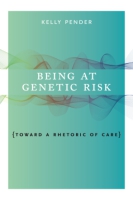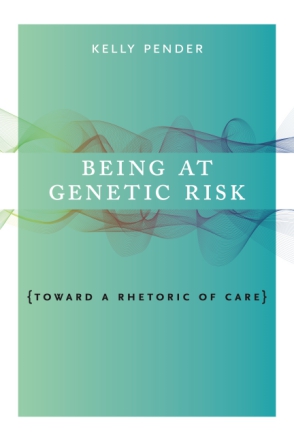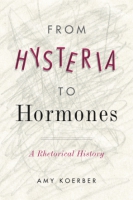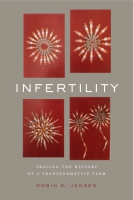Being at Genetic Risk
Toward a Rhetoric of Care
Kelly Pender
“This book is groundbreaking, not only for scholars interested in women’s health, or health or science studies more generally, but also for rhetorical scholars and (post)humanists.”
- Description
- Reviews
- Bio
- Table of Contents
- Sample Chapters
- Subjects
Being at Genetic Risk offers a new set of conceptual starting points for understanding what is at stake with a BRCA diagnosis and what the focus on choice obstructs from view. Through a praxiographic reading of the medical practices associated with BRCA risk, Pender’s analysis shows that genetic risk is not just something BRCA+ women know, but also something that they do. It is through this doing that genetic cancer risk becomes a reality in their lives, one that we can explain but not one that we can explain away.
Well researched and thoughtfully argued, Being at Genetic Risk will be welcomed by scholars of rhetoric and communication, particularly those who work in the rhetoric of science, technology, and medicine, as well as scholars in allied fields who study the social, ethical, and political implications of genetic medicine. Pender’s insight will also be of interest to organizations that advocate for those at genetic risk of breast and ovarian cancers.
“This book is groundbreaking, not only for scholars interested in women’s health, or health or science studies more generally, but also for rhetorical scholars and (post)humanists.”
“Being at Genetic Risk delves deeply into Mol’s concept of ‘logic of care’; set in the context of the risk of a genetic disease (rather than focusing on patients living with a disease or a difficult-to-define symptom), this adds in significant and interesting ways to the conversation.”
“Kelly Pender’s Being at Genetic Risk: Toward a Rhetoric of Care makes an important contribution to scholarship in the rhetoric of health and medicine (RHM); rhetoric of science, technology, and medicine (RSTM); and rhetoric more broadly. The book does so by taking on the important task of questioning critiques ‘debunking’ social creations that dupe naïve people into believing their reality.”
Kelly Pender is Associate Professor of English at Virginia Tech. She is the author of Technē, from Neoclassicism to Postmodernism: Understanding Writing as a Useful, Teachable Art.
Contents
Acknowledgments
Introduction
1 Following Mol’s Lead: From Diabetes to BRCA Risk
2 From Ideology to Governmentality: A Constructivist View of Genetic Risk
3. Making Risk Real: A Praxiographic Inquiry into Being BRCA+
4. Toward a Rhetoric of Care for the At Risk
Conclusion: Invention in RSTM: Another Moderate
Response to the Two-World Problem
Notes
Bibliography
Index
From the Introduction
In her 2008 book, The Logic of Care: Health and the Problem of Patient Choice, Annemarie Mol laments the fact that over the past several decades the bioethical principle of autonomy and its corollary “logic of choice” have played such a dominant role in defining what counts as good medicine. While certainly not advocating a return to the coercive practices of medicine’s past, Mol argues that autonomy and choice are poor ideals for people who are sick. Shaped by a false binary between a paternalistic paradigm in which doctors make all decisions and a civic/consumerist one in which patients can have what they want, this logic values and, indeed, valorizes a type of freedom that is beyond the reach of most patients. That is, the logic of choice promotes the image of rational decision makers who, by weighing various options and exercising their purchasing power, can take control of their health. Yet the reality, Mol argues, is that people who are sick are neither in control nor ever truly free to choose (40–41).Since the early days of the Human Genome Project (HGP), scholars in the social sciences and humanities have been arguing that those at genetic risk of disease face the same predicament. In other words, they have been arguing that choice is as poor an ideal for those whose genes predispose them to a disease as it is for those who have a disease. Typically, these arguments have focused on critique, aiming to expose the means by which logics and rhetorics of choice have allowed those at genetic risk to believe that they have freely chosen what they were, in fact, compelled to choose.While I recognize the historical necessity of such critique, I worry, as Mol does, that it rarely produces the emancipatory effects at which it aims. Patients often experience a lack of choice, but are we always to assume that this lack of choice calls for emancipation? Are we to assume, in other words, that when patients experience a lack of freedom, it is because they have been submitted to the force of an institutional or ideological authority? In Mol’s view, such an assumption overlooks the fact that people who are sick are not free because their bodies—which, in some fashion or another, don’t function properly—require that they engage in care practices in order to live a good life. This requirement is not one from which patients can be liberated. Thus, Mol argues that in order to improve health care, we must turn our attention toward these care practices, putting the rationales that they embody into words so as to offer an alternative to the logic of choice rather than another critique of it. She terms this alternative, appropriately enough, a logic of care.In brief, the primary aim of Being at Genetic Risk: Toward a Rhetoric of Care is to apply Mol’s work within the context of genetic risk, specifically genetic risk for breast and ovarian cancers due to a BRCA mutation. Thus, while my argument begins with a problem that has been identified by many before me (the fact that choice is a poor ideal for the genetically at risk), it responds to this problem differently, extending Mol’s work to demonstrate that for those at genetic risk, a lack of freedom does not necessarily require (or cannot always be remedied by) emancipation. Much of what the genetically at risk say and do, I maintain, escapes the questions of choice and empowerment that have dominated the discourses of genetic medicine and its critics for more than two decades. Thus, we need an alternative way of thinking and talking about their experience. However, rather than conceiving of this alternative as a logic of care, as Mol did, I have conceived of it as a rhetoric of care or, more specifically, as a set of conceptual starting places, or topoi, that can be used to foster a rhetoric of care by highlighting those elements of being at risk that choice (whether it is envisioned as an ethical ideal, an ideological illusion, or a governmental strategy) obstructs from view. Importantly, the primary goal of bringing these other elements into view is not to better represent the experience of being at genetic risk of breast and ovarian cancers. Topoi are better understood as tools than as explanations or representations, and while the specific topoi that I offer here are based on my analysis of various discourses surrounding BRCA risk, they are not meant first and foremost to be a means of explaining those discourses. Rather, these topoi, like all good heuristics, are designed to help us invent and intervene, to move our minds out of their “habitual grooves,” as Richard Young once put it, in order to see and act anew (Young 59).While the primary aim of this book is, indeed, to help us think differently about the experience of being at risk of breast and ovarian cancers, it also seeks to contribute to our understanding of rhetoric. It does this by demonstrating the role that rhetorical invention understood as a productive art, or techne, can play in rhetoric of science, technology, and medicine (RSTM) scholarship.Invention as a productive art has been a major concern in composition and communication pedagogy, but it has had little impact in rhetorical studies of discourse. Typically, when we study the rhetoric of something—a particular discipline, organization, public, or group, for instance—we want to know how that rhetoric performs, that is, how it creates knowledge, constitutes audiences and subjects, secures adherence, selects and deflects realities, and so on. But over the past ten years or so, the introduction and incorporation of new materialist theory into the humanities and social sciences has raised questions about the hermeneutic bent of this type of work, creating, in the process, an exigence for rethinking the role that invention can play as a mode of critical engagement in our field. Evidence of that rethinking is clear in publications like the 2013 issue of POROI, the purpose of which was “to stimulate conversation about the inventional resources” for scholarship in RSTM (Keranen 1), as well as in more recent work like Walsh and Boyle’s 2017 Topologies as Techniques for a Post- Critical Rhetoric, a collection of essays that turn to various notions and practices of topology in order to provide inventive responses to the kinds of wicked problems that more traditional forms of critique have been unable to solve.Being at Genetic Risk provides further evidence of this rethinking of invention, as it draws on the work of rhetoricians like Richard McKeon, Janet Atwill, and John Muckelbauer in order to demonstrate not how rhetoric performs in the biosocial discourses surrounding BRCA risk but instead how that rhetoric can be made to perform (Muckelbauer, The Future of Invention 43). As I will elaborate later, there is no hard- and- fast line between these two activities, and certainly I spend plenty of time in this book explaining how rhetoric performs, but I believe that within those explanations we can orient toward invention, as Muckelbauer puts it, and through that orientation find ways of intervening without demystifying. In arguing for this orientation, my goal is not to privilege invention over hermeneutics as much as it is to move away from a specific kind of hermeneutics that operates within critique, namely a hermeneutics of suspicion. Ultimately I believe that we can interpret with the aim of invention, and that we can interpret with the aim of critique or demystification. Rhetorical studies of genetic risk have historically aimed for this latter set of goals, but as those goals have themselves become suspect, we find ourselves in need of new ways of engaging the discourses that matter to us. It is by responding to this need that Being at Genetic Risk seeks to contribute to our understanding of rhetoric.Getting the Object WrongMy decision to respond to the problem of choice by trying to foster a rhetoric of care is the product of many factors, not the least of which is how convincingly Mol illustrates and calls for such a response in The Logic of Care. But my thinking about the problem of choice in relation to genetic risk began taking shape before I read Mol’s book. To be specific, the arguments I present here began to form in 2008, the year I tested negative for a BRCA mutation but was warned by the oncologist who was treating me not to assume that I was off the hook. I had a family history of breast cancer, but that history didn’t look like a BRCA family history, and without being able to test my mother, who had died in 1989, my negative result didn’t mean a whole lot. In other words, the message from my doctor was be vigilant, because probably there was some other kind of mutation floating around in my family, maybe one of unknown significance, and I should not assume that since it wasn’t on one of the two BRCA genes, that it wouldn’t affect me.Although I was not vigilant in the way my doctor advised (meaning I did not embark on the recommended cancer-screening regimen or have risk- reducing surgery), I did become concerned enough to begin searching for information about genetic susceptibility to breast cancer. Among other places, that search led me to the website of an organization called FORCE, which stands for Facing Our Risk of Cancer Empowered. As the largest nonprofit organization for women and men who have or are at risk of having hereditary breast and ovarian cancers, FORCE is the epicenter of the biosocial universe surrounding BRCA risk. Biosocial is a term that I will use often in this book, as it names the primary type of discourse on which I have focused this study: that which is produced by or about people with inherited predispositions to disease in order to help them manage the medical, social, and psychological issues associated with their predisposition. The term comes from the work of anthropologist Paul Rabinow, who predicted that various forms of “biosociality” would emerge as a result of the HGP. Writing in 1992, well before the appearance of widely available genetic tests, Rabinow argued that as research on the human genome progressed, groups of people would come to know themselves according to the “new truths” produced by genetic medicine, and by “new truths” Rabinow didn’t mean knowledge about “some hypothetical gene for aggression or altruism” (244). To the contrary, he wrote, groups will form around specific alterations in the four nucleotides that make up human DNA, and these groups “will have medical specialists, laboratories, narratives, traditions, and a heavy panoply of pastoral keepers to help them experience, share, intervene in, and ‘understand’ their fate” (244). This vision of the future is clearly borne out by the FORCE website, whose users often refer to themselves as carriers of particular genetic mutations that confer particular types of cancer risk, for instance as “another 187delAG” or a member of the “8525delCs.” But more important than the organization’s association with this type of molecularized identity (at least to me) are the ways in which it tries to help BRCA+ women “experience, share, intervene in, and ‘understand’ their fate.” In addition to providing information about topics ranging from cancer genetics and clinical trials to strategies for managing risk and choosing physicians, FORCE raises money for research, holds an annual conference, publishes a newsletter and brochures, offers a webinar series, advocates for (or against) policies that affect its members, and provides online forums through which users can seek advice and share their experiences. Its founder, Sue Friedman, is also a co- author of one of the most popular guidebooks about BRCA risk, Confronting Hereditary Breast and Ovarian Cancer. Th us, while FORCE is by no means alone in the biosocial universe of BRCA risk, with its website receiving over one million hits and over thirty thousand visits per month, it does stand at the center of that universe, acting as precisely the kind of “pastoral keeper” that Rabinow envisioned.[Excerpt ends here.]
Also of Interest
Mailing List
Subscribe to our mailing list and be notified about new titles, journals and catalogs.






